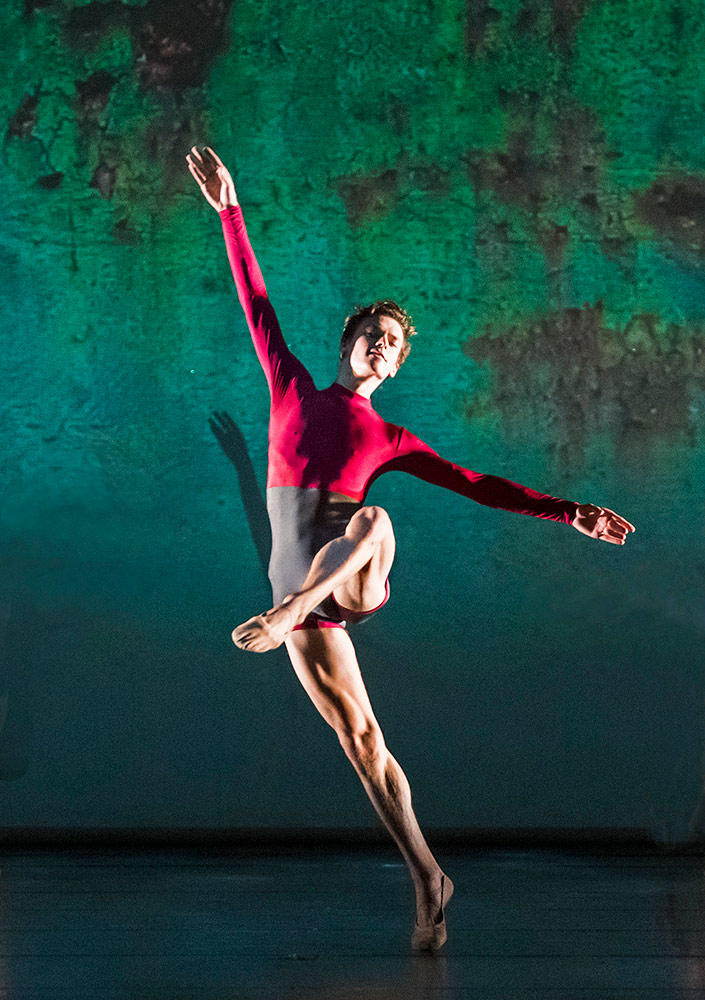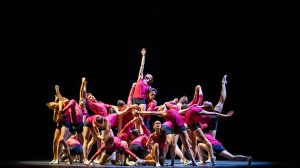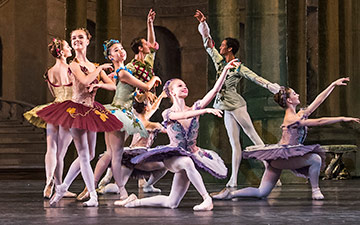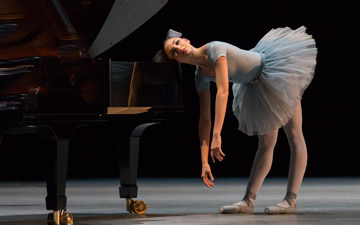
© Tristram Kenton. (Click image for larger version)
Royal Ballet School
La Valse/ Bottega/ Scottish Dances from Flowers of the Forest/ Start Again/ Simple Symphony/ Pulse/ Swan Lake excerpts/ Untied, Undone/ Paquita divertissement/ Grand Défilé
★★★★✰
London, Royal Opera House
14 July 2019
www.royalballetschool.org.uk
www.roh.org.uk
The programme for this year’s Royal Ballet School matinee on the main stage of the Royal Opera House was nearly the same as that in Holland Park ten days earlier (reviewed by Bruce Marriott on 4 July). For this grander occasion, the students had the benefit of the ROH orchestra, conducted by Tim Murray, and backcloths providing a context for the range of works they danced.
They had to adjust their performances for the much bigger stage and auditorium, as Ninette de Valois’ dancers learnt to do when they first moved into the Opera House in 1946. On Sunday afternoon, I was fortunate enough to be seated in the stalls circle, so couldn’t tell whether they projected far enough to reach the back of the amphitheatre. Their outgoing acknowledgement of the audience certainly reached me.

© Tristram Kenton. (Click image for larger version)
The choice of works emphasised ensembles more than individuals. It was interesting to see large numbers of young men dancing together, as well as a more usual female corps de ballet. In La Valse, Ashton has 21 men on stage at different times (not counting the four holding candelabras at the back); at least half of them are required to dance in unison, coat tails flying like birds’ wings, in between partnering the 21 women. In Ashley Page’s new United, Undone, created for the male students, he deploys 15 boys from all three years of the Upper School.
I was impressed by their discipline – it’s not easy for men of varying heights and jumping ability to keep in unison or combine in canon. I was also impressed by their secure multiple turns, with controlled finishes. Many are left-footed, always a reassuring sign of prowess. Kele Roberson, an American scholarship winner who had chosen the Royal Ballet School over a place at the Juilliard School, displayed his street-dance athleticism in a solo, Start Again, which he had choreographed as an audition piece for Nederlands Dans Theater. Needless to say, he has been accepted by NDT II.

© Tristram Kenton. (Click image for larger version)
A second-year student, Daichi Ikarashi, who has stood out at every school performance (he was the high-jumping Frog in Liam Scarlett’s The Cunning Little Vixen at the ROH in February) made his presence felt in Alastair Marriott’s Simple Symphony and in a solo role in Paquita. As well as his soaring elevation, he has an assured insouciance in his virtuoso technique. The principal male role in the Paquita divertissment, whose arrival is heralded by a diagonale of ladies, was elegantly taken by tall Davi Ramos. He will be joining Dutch National Ballet’s junior company.
I much enjoyed Page’s Untied, Undone, to the Saltarello last movement of Mendelssohn’s Italian Symphony. The composer combined two Italian folk dances on different rhythms: Page split his cast into discrete groups, playing with rhythms, numbers and exuberant classical ballet steps. His ingenious choreography rather showed up Marriott’s lack of imagination in his Simple Symphony, to Benjamin Britten’s symphony of the same name: too much unison work for the six female corps members and a finale with awkwardly contrived lifts for eight couples. Why create an adagio pas de deux in which the woman’s first encounter with her partner is to lie on his back?

© Tristram Kenton. (Click image for larger version)
Petal Miller Ashmole’s Bottega for White Lodge pupils from the junior school, years 10 and 11, had the virtue of a courteous pas de deux in which the principal couple, Ella Newton and Luc Foskett, looked at each other trustingly. The derivative choreography for the rest of the youngsters was a preparation for future challenges. It’s very obvious at this stage of the students’ development that the girls are more mature (and taller) than the boys.
They are equal by the third year of the Upper School, as was evident in the Scottish Dances from David Bintley’s Flowers of the Forest for the Sadler’s Wells Royal Ballet, the touring company that became Birmingham Royal Ballet. Bintley has retired as BRB’s artistic director this summer, and the revival of the first scene from his 1988 Flowers of the Forest was included in the students’ programme in his honour.

© Tristram Kenton. (Click image for larger version)
It features the fast, neat footwork of traditional Scottish dancing with nods to Ashton and de Valois, whose choreography demands fleet feet. The three young women, Sarah Keaveny, Ginevra Zambon and Xinyue Zhao, mocked their would-be suitors, Damen Axtens, Matthew Bates and Liam Boswell, who were mainly concerned with showing-off in their swirling kilts. All six filled the stage with movement, giving the impression that they were a much larger gathering of dancers.
Diamond-sharp footwork needed to be in evidence in Paquita, and mostly was, thanks to attentive coaching by Jay Jolley, Daria Klimentova and Nicola Tranah. Tania Fairbairn was responsible for the charming Mazurka by White Lodge youngster that introduced the divertissement. The role of Paquita was taken by Hanna Park, a second year student who won a Prix de Lausanne scholarship for the RBS last year. She already has a formidable technique and command of the stage, but her line and energy don’t yet extend beyond her fingertips. The corps and demi-soloists were diligent, without the panache that Minkus’s Spanish-tinged music demands.

© ASH. (Click image for larger version)
Only the Bolshoi or the Trocks can bring off the bounce and swagger that make Paquita such fun. It’s too much to demand of students (as this year’s English National Ballet School’s performance of Paquita demonstrated). However, the RBS’s Upper School’s account of La Valse, coached by Anita Young and Valeri Hristov, was even better than most of the adult company’s performances of it over the years. These youngsters could dare to take off-balance risks and dizzying lifts that have daunted their elders, in a frenzied waltz that teeters on the edge of an abyss.
So why require students to merge into an anonymous horde for a contemporary dance piece, Pulse, by Spanish choreographer Goya Montero? He made it for a Prix de Lausanne gala last year, bringing together 50 young dancers from different backgrounds. It is superficially effective, relying on simple rhythms (or counts) to music by Owen Belton, a composer often used by choreographer Crystal Pite. Pulse might be a useful preparation for performing mass-movement work, but it’s absurd as a showcase for ambitious ballet-trained students. Dressed alike in steel-grey unitards under gloomy lighting, they surge and slouch in waves, leaving behind an individual in a would-be meaningful way. Maybe this is the kind of clichéd choreography that ballet school graduates must learn to accept and enjoy performing during their future careers.

© Tristram Kenton. (Click image for larger version)
Thankfully, to raise our spirits, the annual matinee ends with Grand Défilé that the School’s previous director, Gailene Stock, devised in 2001. Every member of the School comes on in colour-coded year groups, dancing to Czerny’s Etudes, until the stage is filled with optimistic youngsters, feet crossed in fifth position. It’s always a joy to see the promise of so much talent as one cohort leaves and the rest hope to move up a year for the next annual performances.

















You must be logged in to post a comment.